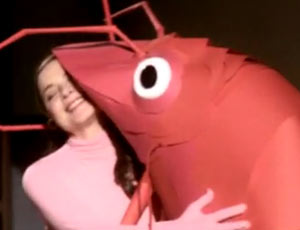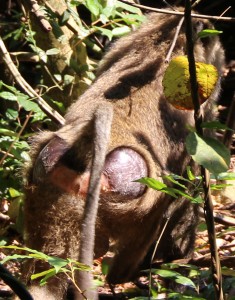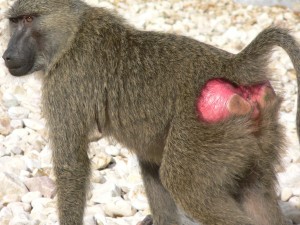Isabella Rossellini is doing a show, Green Porno, in which she performs the mating behavior of a whole range of other species, such as honey bees and spiders. The show is based on a series of videos that she has been making since 2008.

Holy cow. These are awesome – and biologically accurate, in a whimsical, funny way. Rossellini clearly did her homework. But sexy? Not so much, I think. Rossellini herself says that though the bits are called “Green Porno,” “There is nothing porno about them.”
I teach a course on Sex, Evolution and Behavior, in which I occasionally illustrate key points with short video clips of the mating behavior of other species, from slugs to albatrosses. Not for titillation, mind you, but for education. In fact, while such video clips may be weird, or interesting, or comical, or gross, or some combination of these, they are pretty much never even remotely titillating. At least in my opinion. And my impression is that for most people, sex in other species is generally much more icky than sexy.
Which makes me wonder: why might this be the case?
The world is big, and has many kinds of people in it, and perhaps somewhere on the Internet there are sites for people who really do find the mating behavior of lobsters arousing. But I expect those sites are vastly outnumbered by sites depicting the mating behavior of our own species.
So why do we perceive sex in other species to be disgusting rather than sexy?
One possible explanation is that this disgust response is part of an evolved psychological mechanism that promotes mating decisions that enhance, rather than reduce, fitness. If we found slug sex really sexy, rather than disgusting, we might try mating with slugs, which (among other things) would be a real waste of mating effort.
If this hypothesis is right, that disgust at other species’ sexuality is a reproductive isolating mechanism, an adaptation to keep us from mating with the wrong species, then we should find the sexuality of species closely related to us to be particularly disgusting. After all, we probably couldn’t really mate with a slug even if we wanted to, but mating with something more closely related to us, like a chimpanzee, at least seems within the realm of possibility.
Back when the world had multiple species of humans living at the same time, such as our ancestors and the Neanderthals, interspecies mating would have been a real option. And studies of fossils and ancient DNA indicate that such matings did occur, at least on occasion. Given that hybrids can have various genetic problems, such as infertility, individuals are likely to have more offspring if they reliably mate with their own species, rather than some other species. And indeed, many aspects of animal behavior and anatomy appear to be related to species isolating mechanisms: courtship behavior, species-specific coloration patterns, and genitalia designed to fit like a lock and key, so that the parts only fit with the right partner.
So, what about this prediction, that if disgust is a reproductive isolating mechanism, we should find the sex of species closely related to us to be particularly disgusting? I don’t know of any formal studies of this, but from watching and listening to people’s reactions to monkeys at zoos, I get the strong impression that in general, people really do find monkey sex disgusting, as well as funny and embarrassing.
As a primatologist, I have seen lots of monkey sex: baboons, rhesus monkeys, chimpanzees, gelada monkeys, and so on. All these animals have sex in the open, in public, for everyone to see, so you don’t need to be a creeping pervert to see them going at it. In many cases, you would have to make a real effort to avoid it. And none of it, really, is very sexy, from a human point of view. In chimpanzees, mating is a furtive event that lasts six or seven seconds on average, which often ends with the female screaming and darting away from the male, as if she is terrified that he might beat her up. Which he might well do.
In my first field season as a primatologist, studying baboons in Kenya, I spent quite a bit of time looking at baboon bottoms. Not because I am particularly interested in baboon bottoms, but because (1) if you are following baboons, you’re going to see a lot of baboon bottoms, just that’s what you see when they’re walking in front of you, and (2) baboon bottoms display a whole lot of really valuable information about their reproductive state. You can tell whether a baboon is male or female, for example, just by looking at their bottom, even if they are just little kids. Baboons have a region of bare, tough skin going across their top of their bottoms that serves as a seating pad: the ischial callosities.
Males have a continuous seat pad surrounded by a patch of grey skin:

Whereas females have two separate pads, for the left and right cheeks, separated by the genital opening:

You can tell where a female is in her ovulatory cycle, as when a female is approaching her fertile time, the skin of her perineum swells up into a big pink sexual swelling, which looks extremely uncomfortable. And if a female is pregnant, the bare skin above her ischial callosities turns from grey to bright crimson.
When I was first habituating baboons (following them at a distance so they would get used to us and let us observe them at closer range), one afternoon we managed to get close enough to our group to see them resting on the face of the steep cliff where they would spend the night. Peering through my binoculars, I could see one female with what appeared to be a raw, festering sore by the base of her tail. As the weeks went by and the baboons let us get closer, I realized that this “sore” was just the bloody red pregnancy sign. It doesn’t look nearly so nasty when you are close enough to see that is not in fact a festering sore.
So during my ten months of following baboons around, I spent a lot of time looking at their bottoms, drawing pictures of their bottoms, taking notes of their bottoms to learn who was who and what their reproductive state was. At first, some features of baboon bottoms seemed kind of gross. I got used to that. And eventually I learned what sort of bottoms looked especially appealing to male baboons, by seeing who made special efforts to mate with.

But never in my loneliest days in the field did I find baboon bottoms sexy. Sorry babs, that just how it is.
On the other hand, many examples of hybrids exist. For example, as Kate Detwiler has documented, blue monkeys and redtail monkeys at Gombe and several other sites mate and produce hybrid offspring. My first experience studying primates involved a class project looking at the behavior of the hybrid offspring of a sooty mangabey and a mandrill: a mangadrill. So if disgust is part of a reproductive isolation mechanism, it clearly doesn’t always work.
Whether or not disgust is a reproductive isolating mechanism, it certainly plays a big role in regulating sexual behavior. Even within our own species, we perceive many categories of mating behavior as well, kind of gross. Or really gross. Little kids often seem to think that even kissing is pretty gross, much less the other things that grown-ups are rumored to do in private.
And much of the human disgust response makes sense from an evolutionary perspective. For example, various studies have found that women are considerably less interested in graphic depictions of mating than men are. Many men enjoy looking at graphic, impersonal depictions of anatomical function. Many women find that sort of thing disgusting. Instead, they prefer reading romance novels, or watching romantic movies, where sex occurs in the context of relationships developing between realistic characters. Or with vampires. Or werewolves. Whatever.

The emphasis is on the relationship first, anatomy second.
A recent example of this sex difference in action is the case of the politician Anthony Weiner, who sent pictures of his privates to women who were not his wife. One can imagine him thinking, “Hey, I’d love to have women send me naked pictures of themselves! Surely they would like me to do the same for them!” And maybe there are women who would like that. But I think this response by a blogger is more typical: “The truth is, guys, your ‘junk’ is one of the last things we want to see up close via digital or printed media.”
The Golden Rule, “Do unto others as you would have done unto you,” doesn’t work so well in cases where people have strong differences of opinion about what they would like to have done unto them.
And from an evolutionary perspective, this sex difference makes sense. If it is important to be choosy about mating, then being aroused by random sexual images would be counter-productive. In humans, women tend to be choosier than men. This makes sense, because men and women face much different costs from mating. A man who has sex with a random stranger might get the evolutionary “win” of impregnating her without having to do any work bringing up the baby. A woman who has sex with a random stranger may get stuck doing all the work. Thus for men, sex with strangers is an opportunity, whereas for women it is a risk, and best to be avoided. (Unless, for example, that stranger is so amazing that having his baby would be worth the trouble. Elvis, say, or Magic Johnson.) Disgust at random male junk may thus be an important mechanism guiding mating decisions that prove beneficial, at least on an evolutionary timescale.
Even for men, though, sex with strangers can be risky, if those strangers are infected with nasty diseases. So both sexes should be equally disgusted by anything that indicates such an infection, like festering sores.
In humans and certain other animals, including many bird species, sex often happens within a long-term relationship, rather than with random strangers. And just as in many birds and some mammals, like wolves, male humans do a lot of parental care. If a man has good reason to think his wife is mating only with him, and is uninterested in mating with other men, then he will have good reason to believe that her children are his, and that he should invest in them, by bringing them meat, or carrying them around, or changing their diapers, or whatever.
In contrast, among chimpanzees, males and females both mate promiscuously. Males don’t provide any parental care (apart from defending a group feeding territory), so females are always stuck doing all the work of parenting. However, males sometimes kill babies of females that they haven’t mated with. So females have a strong incentive to mate with all the males of her community, to convince them all that they might be her baby’s daddy.
Given this difference in mating strategies, if female chimpanzees used smart phones, they might like nothing better than to receive photos of male chimpanzee private parts. I suppose that’s an experiment that could be done.
Recently, disgust has gotten lots of attention as one of the key moral emotions. In college, I sat in on J. Z. Smith’s Religion in Western Civilization class. In talking about Leviticus, the Biblical book of rules, many of which seem baffling beyond belief, Smith argued that “the complaint of the writers of Leviticus was not, ‘God, why have you made me such a sinful being.’ No, it was more like, ‘Why have you made me with so many holes?’” Humans leak all sorts of disgusting substances from their various orifices, and many of the rules of Leviticus involve proper regulation of these fluids.
Smith seemed to think that these rules involved a fairly arbitrary sense of disgust, rooted more in aesthetics than reason. For example, he argued that Jewish dietary law forbade eating pork because pigs are disgusting animals. They wallow in filth, they eat trash, we shouldn’t incorporate such filthy animals into our bodies. Smith argued that the argument that such laws protected Jews from trichinosis was an invention of 19th century Reform Jews who wanted to find more rational foundations for traditional beliefs.
More recently, Paul Rozin and others have argued that rather than being arbitrary, disgust really is rooted in evolutionary logic: many things that we find disgusting are dangerous: rotting meat, maggots, festering sores, snot, feces and the like can all transmit pathogens. If we eat such things, or even touch them, they can make us sick, or dead. From an evolutionary perspective, it makes sense to have emotional mechanisms that make us avoid such potentially dangerous substances. In this view, feelings of disgust originally based in avoidance of pathogens have expanded to provide one of the main foundations of moral feeling.
A moral emotion like disgust can guide behavior more quickly, and more reliably, than rational arguments. If we had to stop to think and debate amongst ourselves whether rotting carcasses, for example, were safe to touch, we might pick them up and expose ourselves to all sorts of pathogens before we have persuaded ourselves that maybe that’s not such a good idea. The same way with many moral actions: if people think an immediate, gut response of disgust to pedophilia, or rape, or murder, they will be inhibited from even giving it a try.
Disgust seems to involve both learned and innate components, and develops gradually as children mature. Toddlers, for example, seem to find nothing disgusting. But pretty much everyone eventually grows up to find rotting meat and vomit disgusting. People seem to have a natural disposition to develop feelings of disgust towards things that carry a strong risk of infection.
More recently, Jonathan Haidt and others have argued that disgust is at the heart of the six moral foundations or dimensions: care/harm, fairness/cheating, liberty/oppression, loyalty/betrayal, authority/subversion, and sanctity/degradation. In this view, disgust is involved mainly in the sanctity/degradation dimension.
Much of the current political debate about gay marriage involves tension between these different moral foundations. People who emphasize the first three moral dimensions see gay marriage mainly in light of care (we shouldn’t cause emotional harm to people by denouncing their private life choices as sinful), fairness (it’s only fair that people who love each other should be allowed to marry), and liberty (people should be free to be who they are and love who they love). People who emphasize the other dimensions see gay marriage mainly as an issue of authority (scripture says it is wrong) and sanctity (heterosexual marriage is a sacrament; homosexual marriage is wrong). Thus, people on both sides of the debate are morally outraged by the arguments of people on the other side.
And from an evolutionary point of view, an aversion to same-sex mating seems to make a certain amount of sense: such mating doesn’t produce offspring. But it turns out that evolution is more complicated than that. For some species, homosexual mating is not a preference or orientation for a portion of the population; it’s obligatory. For example, New Mexico whiptail lizard reproduces parthenogenetically; the species has only females, and they are all virgins. Nonetheless, even though their eggs are not fertilized, females still have go through the motions of mating, with another female, in order to produce eggs. (Incidentally, this unusual mating system seems to be a result of the hybridization between two other lizard species.)
And even in species that have both males and females, homosexual behavior occurs in a wide range of species. Among Laysan albatrosses in Hawaii, for example, there appears to be a shortage of adult males. Raising a baby albatross takes a huge amount of work. Mom and dad have to take turns flying far away to get fish to feed baby, while the other parent stays with the nest. A single parent just can’t manage. As a result, many females pair with other females. They mate with males who are paired with other females, but nest and raise chicks together with their female life partner.
Rossellini says her Green Porno doesn’t have a political agenda. It is more about educating people about what the world is like for other species. But her videos do an excellent job of illustrating that in nature, sex involves an enormous range of diversity, from the exploding kamikaze penises of honeybees to the playful, anything goes sex of dolphins.
And learning more about the sex lives of other animals is useful for getting a broader perspective for the behavior of our own species, whatever we might personally find to be disgusting. Or not.

Hi Mike. I have always though female human “T&A” function as species markers, being particularly attractive to human males as they separate us from our chimpy relatives. Also, I believe it was in Roger Fouts book, he mentions the chimp Lucy liked to look at Playgirl magazine. Not exactly chimp porn, but she was pretty mixed up…
Hi Jen, that’s an interesting idea! They certainly seem to be part of the package. Yes, Roger Fouts does describe Lucy being a fan of Playgirl (was it just for the articles? I don’t think so…) That would fit with the idea that female chimps would be more interested in male visual displays. Since Lucy was raised by people that must have had a big impact on the development of her mate preferences.
Jen, just following up on this — what we would really want to know is what traits would have been most noticeably different between, say, early modern humans and other closely related species. Some features, like wider hips and rounded buttocks, are likely mainly the result of being bipedal and (in women) having to have a pelvis wide enough to squeeze a big-brained baby out. I bet from the waist down, Neanderthals and other early humans would have been pretty similar to modern humans, except more robust. Most of the hypotheses I’ve encountered about the origin of distinctively human breasts have focused on their role as cues of fertility and nubility, rather than species identification — this is an interesting idea. Maybe we’ll find out if someone clones Neanderthals… In her Clan of the Cave Bear books, Jean Auel has the Cro Magnon people (anatomically modern humans) disgusted by the appearance of the Neanderthals, with their brow ridges and flatter, sloping heads of Neanderthals. They use the slur “Flatheads” to refer to the Neanderthals, who they consider disgusting animals rather than proper humans. But this still doesn’t stop some young Cro Magnon men from raping Neanderthal women. This combination of disgust and desire seems entirely plausible to me (unlike some other aspects of these books, like the Neanderthals’ race memories and the shamans’ psychic powers).
I’m thinking about this in context of another article I read about arousal lowering a woman’s disgust threshold (for want of a better term). (Borg C, de Jong PJ (2012) Feelings of Disgust and Disgust-Induced Avoidance Weaken following Induced Sexual Arousal in Women. PLoS ONE 7(9): e44111. doi:10.1371/journal.pone.0044111). Unfortunately, I’m doped to the gills on cold medicine and can’t seem to formulate my thoughts coherently. But I’m wondering about this threshold idea and the (dis)advantages of having it be a moving target.
Thanks for this, Rob! Interesting article, with a nice quote from Freud:
“A man, who will kiss a pretty girl’s mouth passionately, may perhaps be disgusted by the idea of using her tooth-brush.”